Tracking Unauthorized Access Using Machine Learning and PCA for Face Recognition Developments
Abstract
1. Introduction
1.1. Literature Review on ML Algorithms for FR
1.1.1. Methodology Approach
1.1.2. PCA
1.1.3. AdaBoost
1.2. Current Study
2. Materials and Methods
3. Results
- OpenCV—a programming function library targeted mostly at real-time computer vision, this library uses ML algorithms to search for a face in the given picture;
- NumPy—a Python library that adds support for big, multi-dimensional arrays and matrices, as well as a wide variety of high-level mathematical functions to operate on these arrays;
- MySQL Connector—a Python library that provides interaction between the MySQL Workbench Database and the application;
- Pickle—a library that serializes and deserializes Python object structures. It is used in this material to serialize the array of face coordinates for the database of faces loaded in the application;
- Open Neural Network Exchange (ONNX) library—an open-source AI ecosystem comprising of technology businesses and academic groups that build open standards for describing ML techniques and software tools to foster AI innovation and cooperation.
- ONNX Runtime—a cross-platform network accelerator for DL with a versatile interface for integrating hardware-specific libraries.
4. Discussion
4.1. Authorization Access for Employees, in Any Domain
4.2. Airport Security
4.3. Law Enforcement
4.4. Financial Sector
5. Conclusions
- firstly, such a solution proves to be smart, safe, and a very affordable access control tool that can be applied in any business or entity throughout the world;
- secondly, this software can facilitate the embarking process safer, quicker, and more efficient in any airport;
- thirdly, the proposed system can help law enforcement agencies to prevent criminal activities and to catch fugitive persons faster by reducing the costs and the time used by the Law Enforcement Agencies;
- fourthly, this application can prove to be very efficient in the banking system and in smart retail domains, too.
Author Contributions
Funding
Conflicts of Interest
References
- Pati, R.; Pujari, A.K.; Gahan, P. Face recognition using particle swarm optimization based block ICA. Multimed. Tools Appl. 2021, 80, 35685–35695. [Google Scholar] [CrossRef]
- Face Processing: Advanced Modeling and Methods, 1st ed.; Zhao, W., Chellappa, R., Eds.; Academic Press: Cambridge, MA, USA, 2011; pp. 15–36. [Google Scholar]
- Samaria, F.S.; Harter, A.C. Parameterisation of a stochastic model for human face identification. In Proceedings of the 1994 IEEE Workshop on Applications of Computer Vision, Saratosa, FL, USA, 5–7 December 1994; pp. 138–142. [Google Scholar]
- AT&T Laboratories Cambridge. The Database of Faces. Available online: https://cam-orl.co.uk/facedatabase.html (accessed on 1 August 2022).
- Clarivate Web of Science. Available online: https://www.webofscience.com (accessed on 21 July 2022).
- Monkeylearn. No-Code Text Analytics. Available online: https://monkeylearn.com/ (accessed on 20 July 2022).
- Bowyer, K.W.; Chang, K.; Flynn, P. A survey of approaches and challenges in 3D and multi-modal 3D+2D face recognition. Comput. Vis. Image Underst. 2006, 101, 1–15. [Google Scholar] [CrossRef]
- Bowyer, K.W.; Chang, K.; Flynn, P. A survey of 3D and multi-modal 3D + 2D face recognition. In Proceedings of the International Conference on Pattern Recognition (ICPR) 2004, Cambridge, UK, 26 August 2004. [Google Scholar]
- Abate, A.F.; Nappi, M.; Riccio, D.; Sabatino, G. 2D and 3D face recognition: A survey. Pattern Recognit. Lett. 2007, 28, 1885–1906. [Google Scholar] [CrossRef]
- Cheng, Z.; Zhu, X.; Gong, S. Face re-identification challenge: Are face recognition models good enough? Pattern Recognit. 2020, 107, 107422. [Google Scholar] [CrossRef]
- Krishna, I.M.V.; Kanth, R.M.; Sowjanya, V. Machine Learning Based Face Recognition System. ECS Trans. 2022, 107, 19979. [Google Scholar] [CrossRef]
- Lee, G. Fast and more accurate incremental-decremental principal component analysis algorithm for online learning of face recognition. J. Electron. Imaging 2021, 30, 043012. [Google Scholar] [CrossRef]
- Gang, A.; Bajwa, W.U. A linearly convergent algorithm for distributed principal component analysis. Signal Process. 2022, 193, 108408. [Google Scholar] [CrossRef]
- Kumar, R.S. Principal Component Analysis: In-Depth Understanding through Image Visualization. Available online: https://towardsdatascience.com/principal-component-analysis-in-depth-understanding-through-image-visualization-892922f77d9f (accessed on 19 July 2022).
- Derksen, L.; Xifara, D. Visualising High-Dimensional Datasets Using PCA and t-SNE. Available online: http://luckylwk.github.io/2015/09/13/visualising-mnist-pca-tsne/ (accessed on 19 July 2022).
- Pan, Z.; Healey, G.; Prasad, M.; Tromberg, B. Face recognition in hyperspectral images. IEEE Trans. Pattern Anal. Mach. Intell. 2003, 25, 1552–1560. [Google Scholar] [CrossRef]
- Medioni, G.; Waupotitsch, R. Face modeling and recognition in 3-D. In Proceedings of the 2003 IEEE International SOI Conference, Nice, France, 17 October 2003. [Google Scholar]
- Lu, X.; Jain, A.K.; Colbry, D. Matching 2.5D face scans to 3D models. IEEE Trans. Pattern Anal. Mach. Intell. 2005, 28, 31–43. [Google Scholar] [CrossRef]
- Chang, K.J.; Bowyer, K.W.; Flynn, P.J. Effects on facial expression in 3D face recognition. In Biometric Technology for Human Identification II, Proceedings of the Defense and Security Conference, Orlando, FL, USA, 28 March–1 April 2005; Jain, A.K., Ratha, N.K., Eds.; Society of Photo-Optical Instrumentation Engineers: Bellingham, WA, USA, 2005; Volume 5779, pp. 132–143. [Google Scholar]
- Tsalakanidou, F.; Tzovaras, D.; Strintzis, M.G. Use of depth and color eigenfaces for face recognition. Pattern Recognit. Lett. 2003, 24, 1427–1435. [Google Scholar] [CrossRef]
- Papatheodorou, T.; Rueckert, D. Evaluation of automatic 4D face recognition using surface and texture registration. In Proceedings of the Sixth IEEE International Conference on Automatic Face and Gesture Recognition, Seoul, Republic of Korea, 19 May 2004; pp. 321–326. [Google Scholar] [CrossRef]
- Bronstein, A.M.; Bronstein, M.M.; Kimmel, R. Expression-invariant 3D face recognition. In Audio- and Video-Based Biometric Person Authentication; Kittler, J., Nixon, M.S., Eds.; Lecture Notes in Computer Science Volume 2688; Springer: Berlin/Heidelberg, Germany, 2003; pp. 62–70. [Google Scholar] [CrossRef]
- Beumier, C.; Acheroy, M. Automatic 3D face authentication. Image Vis. Comput. 2000, 18, 315–321. [Google Scholar] [CrossRef]
- Wang, Y.; Pan, G.; Wu, Z.; Han, S. Sphere-Spin-Image: A Viewpoint-Invariant Surface Representation for 3D Face Recognition. In Computational Science–ICCS 2004, Proceedings of the 4th International Conference on Computational Science (ICCS 2004), Kraków, Poland, 6–9 June 2004; Bubak, M., van Albada, G.D., Sloot, P.M.A., Dongarra, J., Eds.; Springer: Berlin/Heidelberg, Germany, 2004; pp. 427–434. [Google Scholar]
- Lu, R.; Zhu, F.; Hao, Y.; Wu, Q. Simple and efficient improvement of spin image for three-dimensional object recognition. Opt. Eng. 2016, 55, 113102. [Google Scholar] [CrossRef]
- Papoulis, A.; Pillai, S.U. Probability, Random Variables, Stochastic Processes; McGraw Hill: New York, NY, USA, 2002; pp. 120–151. [Google Scholar]
- Haykin, S. Neural Networks: A Comprehensive Foundation; Macmillan Publishing: New York, NY, USA, 1999. [Google Scholar]
- Bera, S.; Shrivastava, V.K. Analysis of various optimizers on deep convolutional neural network model in the application of hyperspectral remote sensing image classification. Int. J. Remote Sens. 2020, 41, 2664–2683. [Google Scholar] [CrossRef]
- Eleyan, A.; Demirel, H. PCA and LDA Based Neural Networks for Human Face Recognition. In Face Recognition; Delac, K., Grgic, M., Eds.; IntechOpen: London, UK, 2007; pp. 93–106. [Google Scholar] [CrossRef][Green Version]
- Delac, K.; Grgic, M.; Grgic, S. Image compression effects in face recognition systems. In Face Recognition; Delac, K., Grgic, M., Eds.; IntechOpen: London, UK, 2007; pp. 75–92. [Google Scholar]
- Sharma, R.; Patterh, M.S. A Systematic Review of PCA and Its Different Form for Face Recognition. Int. J. Sci. Eng. Res. 2014, 5, 1306–1309. [Google Scholar]
- Bazama, A.; Mansur, F.; Alsharef, N. Security System by Face Recognition. AlQalam J. Med. Appl. Sci. 2021, 4, 58–67. [Google Scholar]
- Patel, V.M.; Chen, Y.-C.; Chellappa, R.; Phillips, P.J. Dictionaries for image and video-based face recognition. J. Opt. Soc. Am. A 2014, 31, 1090–1103. [Google Scholar] [CrossRef]
- Sirovich, L.; Kirby, M. Low-dimensional procedure for the characterization of human faces. J. Opt. Soc. Am. A 1987, 4, 519–524. [Google Scholar] [CrossRef]
- ORL: Our Database of Faces by AT&T Laboratories Cambridge. Available online: https://www.v7labs.com/open-datasets/orl (accessed on 10 June 2022).
- Bing, H.; Xianfeng, H.; Ruizhen, H. Research of Face Detection Based on AdaBoost and ASM. Open Cybern. Syst. J. 2014, 8, 183–190. [Google Scholar] [CrossRef]
- Gormley, M. Lecture Notes on Introduction to Machine Learning: PCA + AdaBoost. 2018. Available online: http://www.cs.cmu.edu/~mgormley/courses/10601-s18/slides/lecture30-pca-adaboost.pdf (accessed on 10 June 2022).
- Mahmood, Z.; Ali, T.; Khattak, S.; Khan, S.U. A comparative study of baseline algorithms of face recognition. In Proceedings of the 2014 12th International Conference on Frontiers of Information Technology, Islamabad, Pakistan, 17–19 December 2014; pp. 263–268. [Google Scholar]
- Ehlers, A.; Baumann, F.; Spindler, R.; Glasmacher, B.; Rosenhahn, B. PCA enhanced training data for adaboost. In Computer Analysis of Images and Patterns, Proceedings of the 2011 International Conference on Computer Analysis of Images and Patterns (CAIP 2011), Seville, Spain, 29–31 August 2011; Real, P., Diaz-Pernil, D., Molina-Abril, H., Berciano, A., Kropatsch, W., Eds.; Springer: Berlin/Heidelberg, Germany, 2011; pp. 410–419. [Google Scholar]
- Kao, I.-H.; Chan, C.-Y. Comparison of Eye and Face Features on Drowsiness Analysis. Sensors 2022, 22, 6529. [Google Scholar] [CrossRef]
- Yang, Y. Smart community security monitoring based on artificial intelligence and improved machine learning algorithm. J. Intell. Fuzzy Syst. 2020, 38, 7351–7363. [Google Scholar] [CrossRef]
- He, D.; He, X.; Yuan, R.; Li, Y.; Shen, C. Lightweight network-based multi-modal feature fusion for face anti-spoofing. Vis. Comput. 2022. [Google Scholar] [CrossRef]
- Wang, C.; Xu, S.; Yang, J. Adaboost Algorithm in Artificial Intelligence for Optimizing the IRI Prediction Accuracy of Asphalt Concrete Pavement. Sensors 2021, 21, 5682. [Google Scholar] [CrossRef]
- Natras, R.; Soja, B.; Schmidt, M. Ensemble Machine Learning of Random Forest, AdaBoost and XGBoost for Vertical Total Electron Content Forecasting. Remote Sens. 2022, 14, 3547. [Google Scholar] [CrossRef]
- Ahmad, I.; Ul Haq, Q.E.; Imran, M.; Alassafi, M.O.; AlGhamdi, R.A. An Efficient Network Intrusion Detection and Classification System. Mathematics 2022, 10, 530. [Google Scholar] [CrossRef]
- Ding, Y.; Zhu, H.; Chen, R.; Li, R. An Efficient AdaBoost Algorithm with the Multiple Thresholds Classification. Appl. Sci. 2022, 12, 5872. [Google Scholar] [CrossRef]
- Crumpler, W. How Accurate are Facial Recognition Systems–and Why Does It Matter? Strategic Technologies Blog. 2020. Available online: https://www.csis.org/blogs/technology-policy-blog/how-accurate-are-facial-recognition-systems-%E2%80%93-and-why-does-it-matter (accessed on 8 October 2022).
- Yin, C.; Zhu, Y.; Fei, J.; He, X. A Deep Learning Approach for Intrusion Detection Using Recurrent Neural Networks. IEEE Access 2017, 5, 21954–21961. [Google Scholar] [CrossRef]
- Jia, Y.; Wang, M.; Wang, Y. Network intrusion detection algorithm based on deep neural network. IET Inf. Secur. 2019, 13, 48–53. [Google Scholar] [CrossRef]
- Vinayakumar, R.; Alazab, M.; Soman, K.P.; Poornachandran, P.; Al-Nemrat, A.; Venkatraman, S. Deep Learning Approach for Intelligent Intrusion Detection System. IEEE Access 2019, 7, 41525–41550. [Google Scholar] [CrossRef]
- Kasongo, S.M.; Sun, Y. A Deep Learning Method With Filter Based Feature Engineering for Wireless Intrusion Detection System. IEEE Access 2019, 7, 38597–38607. [Google Scholar] [CrossRef]
- Kanimozhi, V.; Jacob, P. UNSW-NB15 dataset feature selection and network intrusion detection using deep learning. Int. J. Recent Technol. Eng. 2019, 7, 443–446. [Google Scholar]
- Mahalakshmi, G.; Uma, E.; Aroosiya, M.; Vinitha, M. Intrusion Detection System Using Convolutional Neural Network on UNSW NB15 Dataset. In Advances in Parallel Computing Technologies and Applications; Hemanth, D.J., Elhosney, M., Nguyen, T.N., Lakshmann, S., Eds.; IOS Press: Amsterdam, The Netherlands, 2021; Volume 40, p. 1. [Google Scholar]
- Fu, Y.; Du, Y.; Cao, Z.; Li, Q.; Xiang, W. A Deep Learning Model for Network Intrusion Detection with Imbalanced Data. Electronics 2022, 11, 898. [Google Scholar] [CrossRef]
- Mijalkovic, J.; Spognardi, A. Reducing the False Negative Rate in Deep Learning Based Network Intrusion Detection Systems. Algorithms 2022, 15, 258. [Google Scholar] [CrossRef]
- Lin, C.-L.; Huang, Y.-H. The Application of Adaptive Tolerance and Serialized Facial Feature Extraction to Automatic Attendance Systems. Electronics 2022, 11, 2278. [Google Scholar] [CrossRef]
- Gough, S. Current RFID Trends and Challenges You Should Know About, in RFID JOURNAL LIVE! 2021. Available online: https://rfidjournallive.com/content/blog/current-rfid-trends-and-challenges-you-should-know-about/ (accessed on 22 August 2022).
- Martin, R.C. Clean Code: A Handbook of Agile Software Craftsmanship; Pearson Education: London, UK, 2009. [Google Scholar]
- Martin, R.C. Clean Code-Refactoring, Patterns, Testen und Techniken für sauberen Code: Deutsche Ausgabe; MITP-Verlags GmbH & Co. KG: Bonn, Germany, 2013. (In German) [Google Scholar]



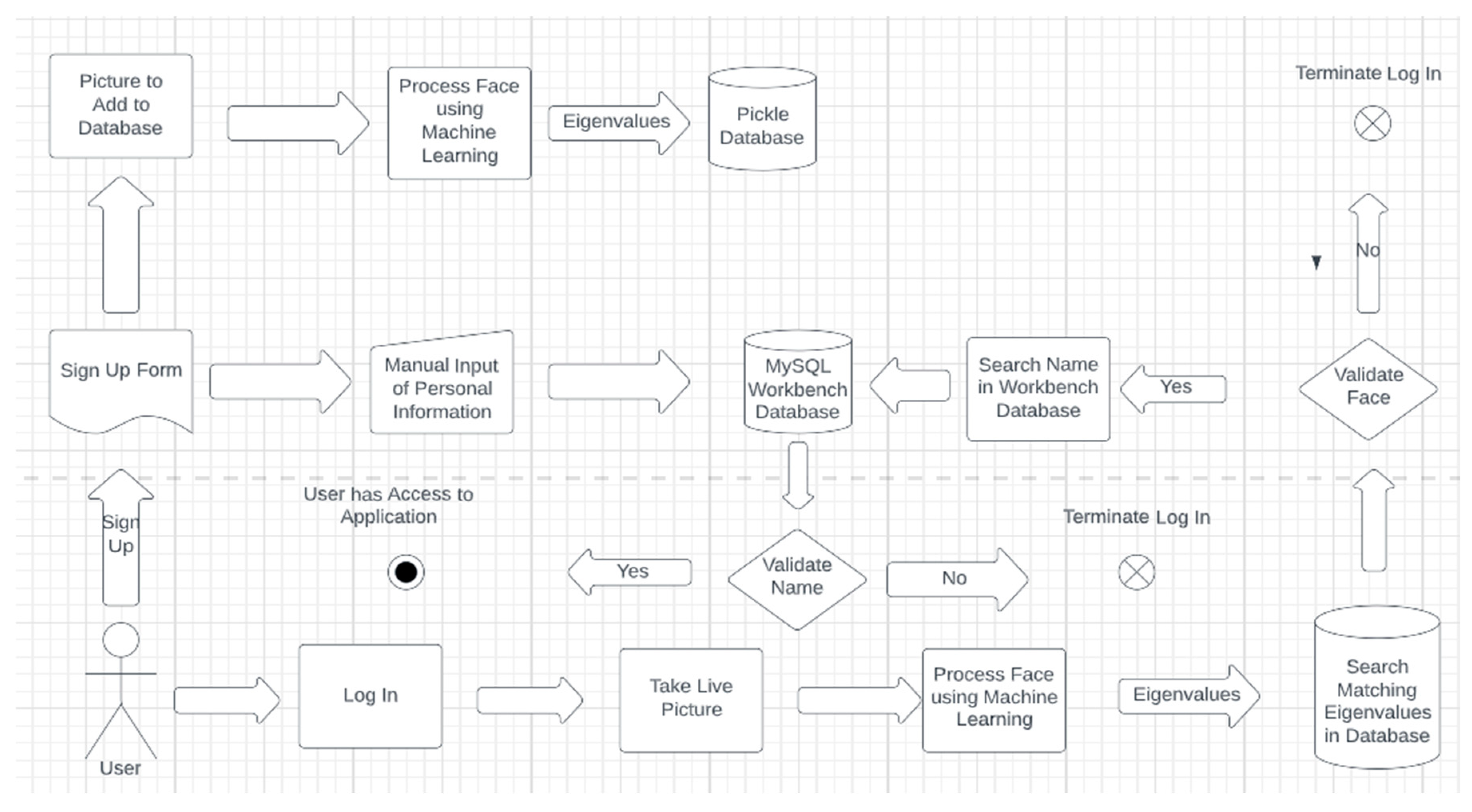

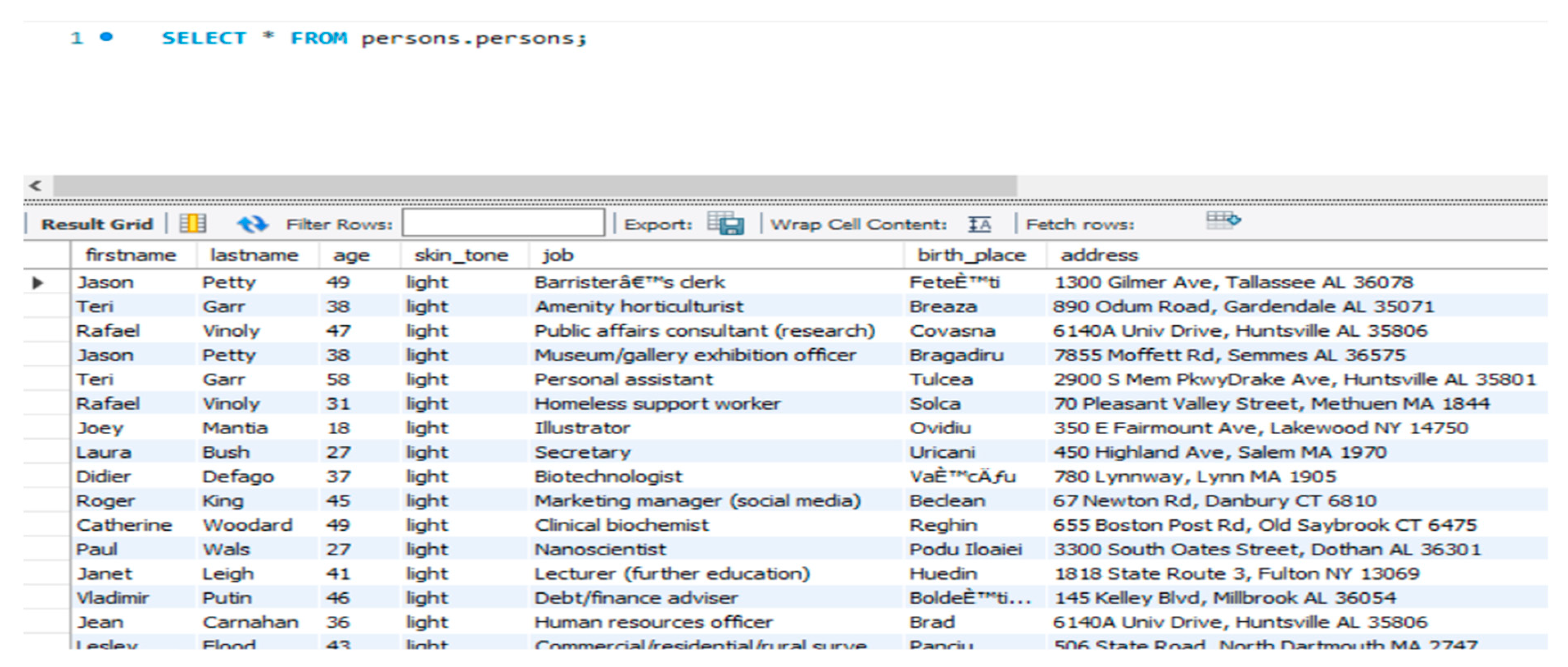
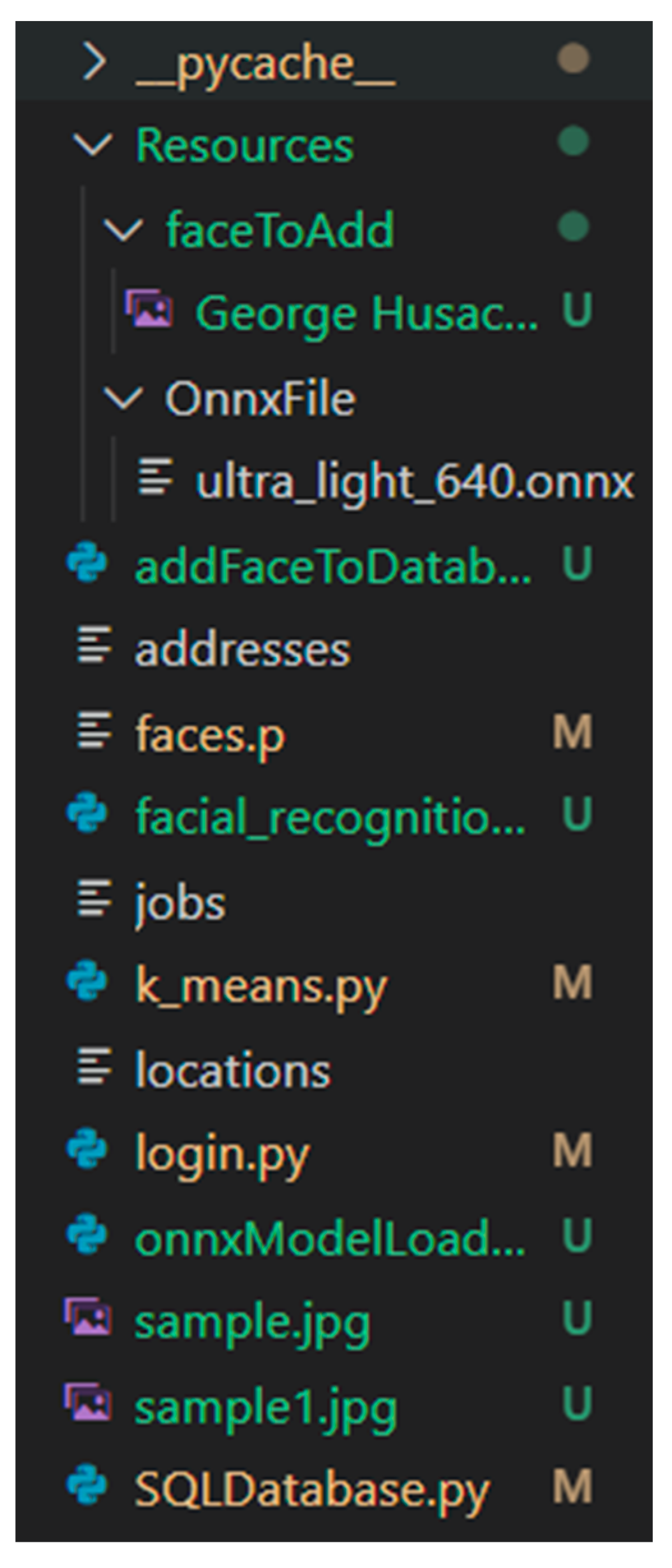

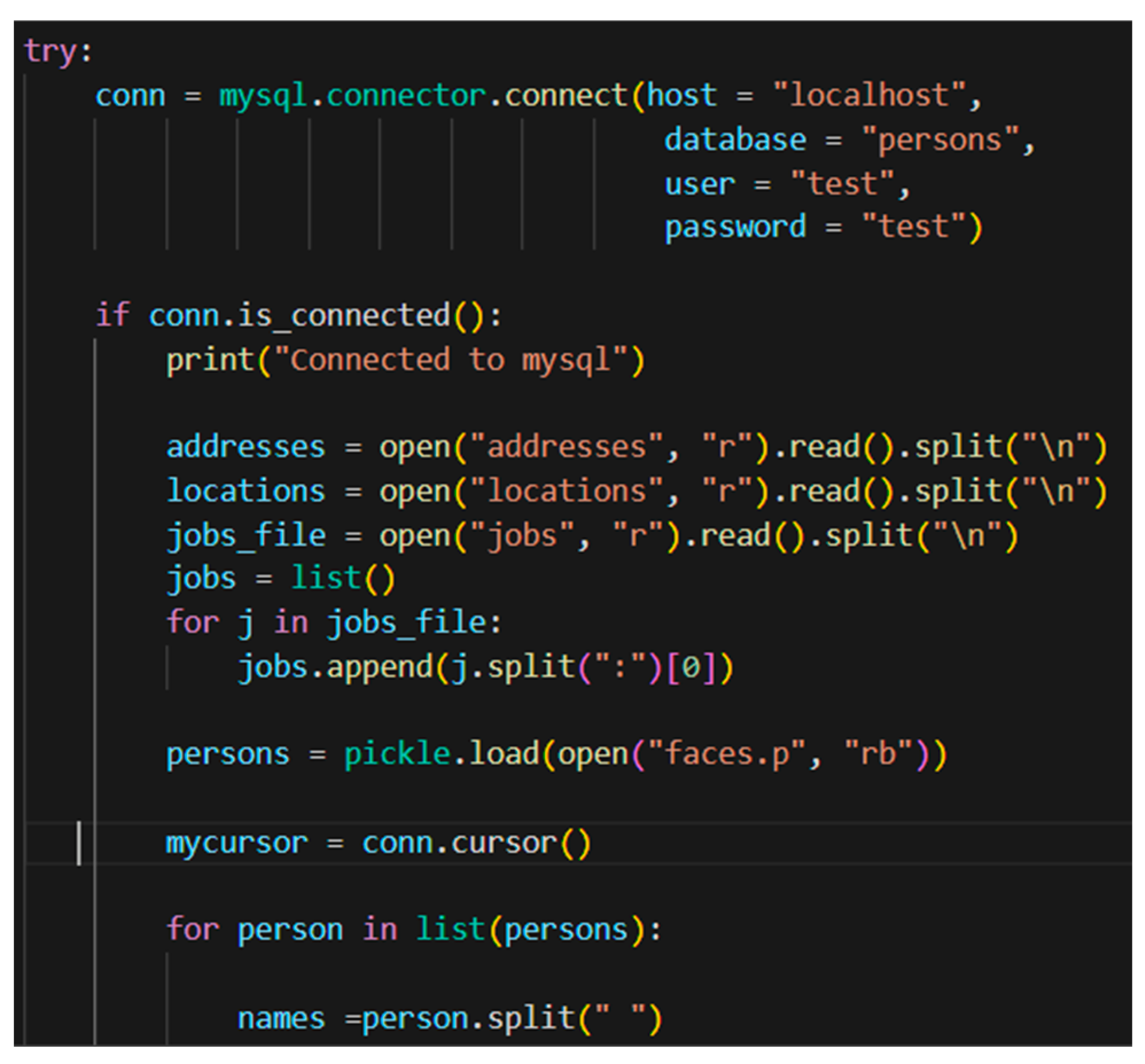

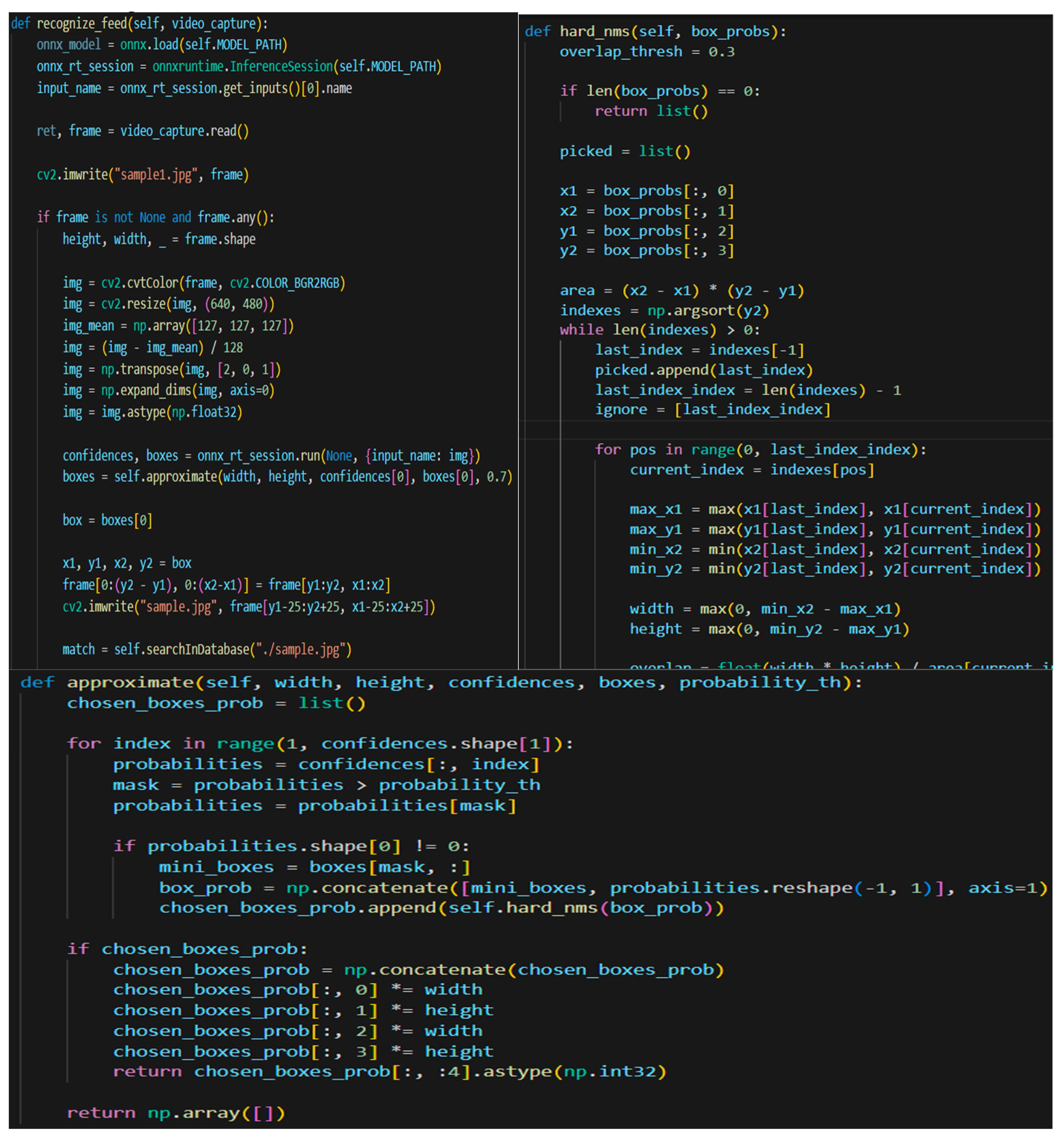
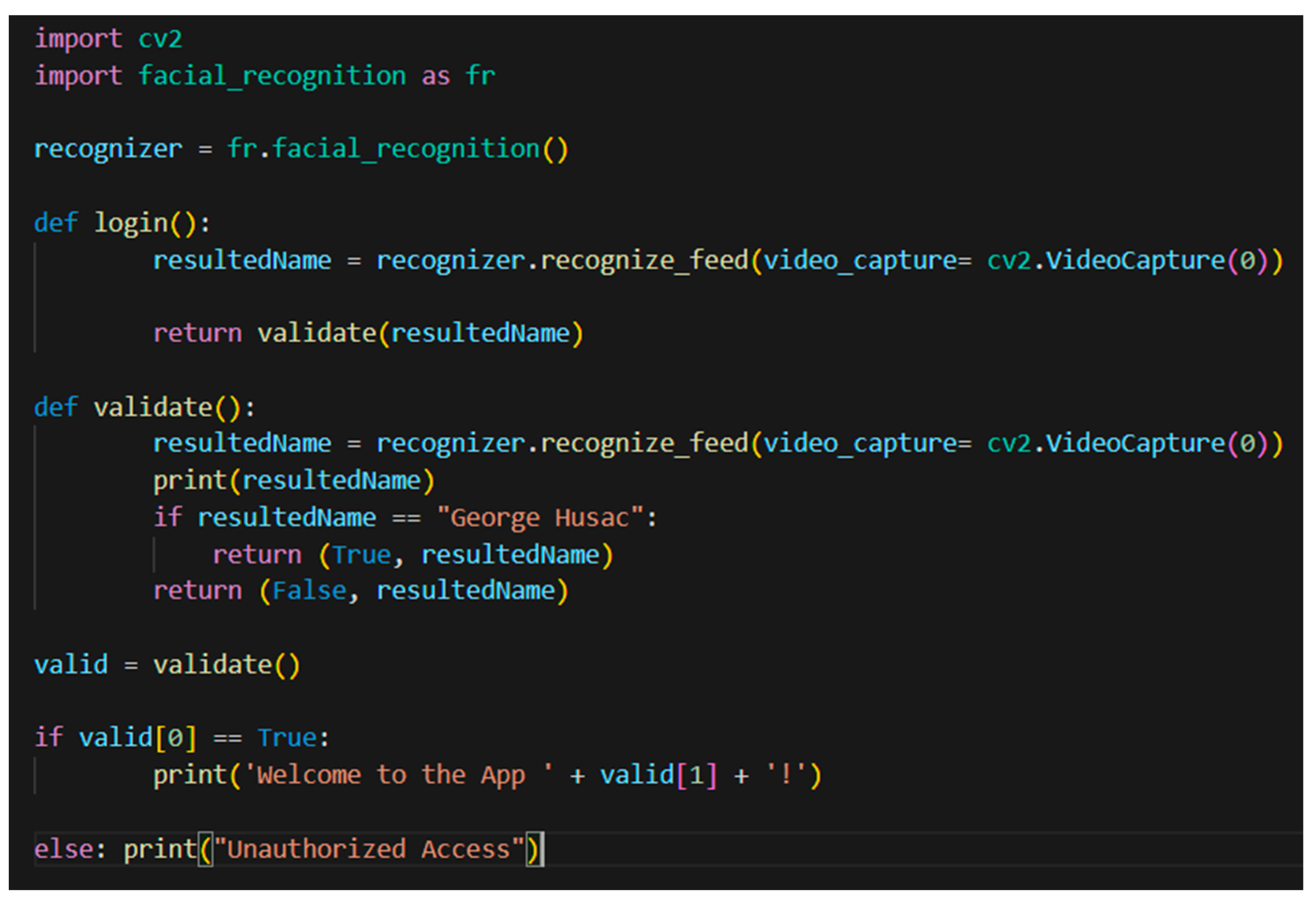
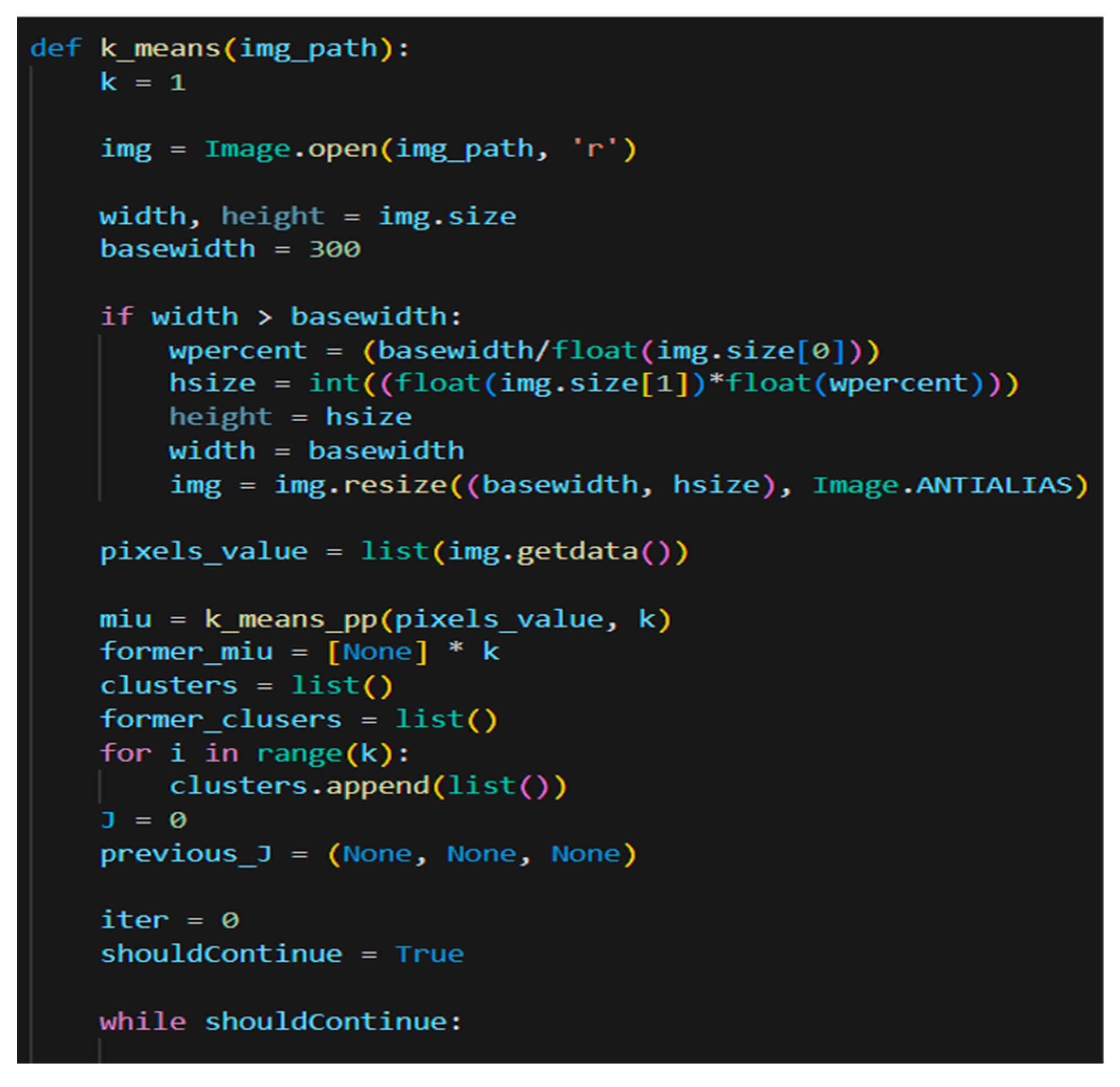
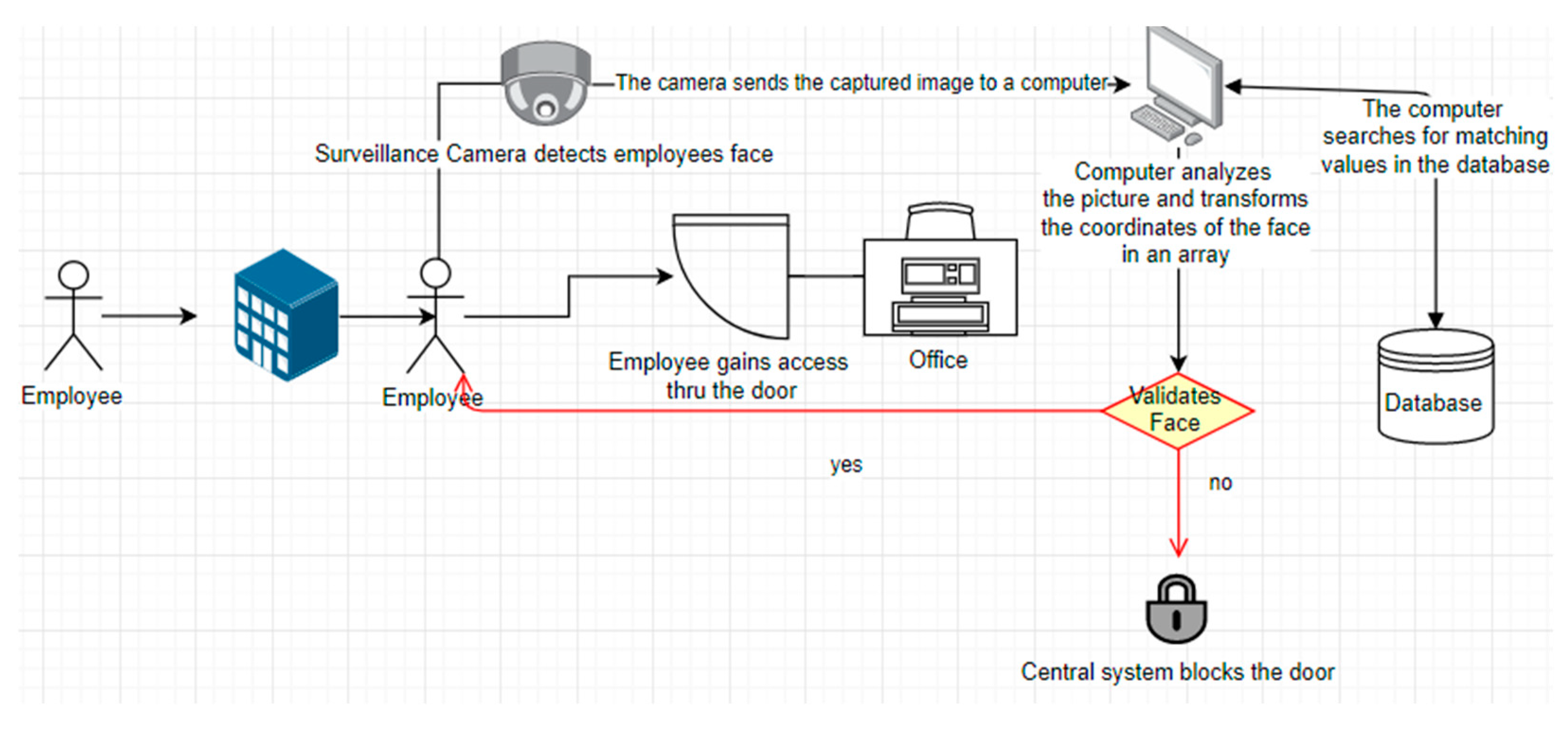
| Researchers | Year | Dataset(s) | AI Technique | Accuracy |
|---|---|---|---|---|
| Yin et al. [48] | 2017 | NSL-KDD | Recurrent neural network | 83.28% (binary), 81.29% (multiclass) |
| Jia et al. [49] | 2019 | KDD Cup 99 and NSL-KDD | Deep Neural Network | 98% |
| Vinayakumar et al. [50] | 2019 | KDD Cup 99, NSL-KDD, Kyoto, UNSW-NB15, WSN-DS and CICIDS 2017 | Deep neural network | Big variations between datasets |
| Kasongo et al. [51] | 2019 | NSL-KDD | Deep neural network | 86.76% (binary), 86.62% (multiclass) |
| Kanimozhi et al. [52] | 2019 | UNSW-NB15 | Deep neural network | 89% |
| Mahalakshmi et al. [53] | 2021 | UNSW-NB15 | Convolutional neural network | 93.5% |
| Fu et al. [54] | 2022 | NSL-KDD | Deep neural network | 90.73% |
| Mijalkovic J., et al. [55] | 2022 | NSL-KDD and UNSW-NB15 | Deep neural network | 97% for UNSW-NB15 |
Disclaimer/Publisher’s Note: The statements, opinions and data contained in all publications are solely those of the individual author(s) and contributor(s) and not of MDPI and/or the editor(s). MDPI and/or the editor(s) disclaim responsibility for any injury to people or property resulting from any ideas, methods, instructions or products referred to in the content. |
© 2022 by the authors. Licensee MDPI, Basel, Switzerland. This article is an open access article distributed under the terms and conditions of the Creative Commons Attribution (CC BY) license (https://creativecommons.org/licenses/by/4.0/).
Share and Cite
Păvăloaia, V.-D.; Husac, G. Tracking Unauthorized Access Using Machine Learning and PCA for Face Recognition Developments. Information 2023, 14, 25. https://doi.org/10.3390/info14010025
Păvăloaia V-D, Husac G. Tracking Unauthorized Access Using Machine Learning and PCA for Face Recognition Developments. Information. 2023; 14(1):25. https://doi.org/10.3390/info14010025
Chicago/Turabian StylePăvăloaia, Vasile-Daniel, and George Husac. 2023. "Tracking Unauthorized Access Using Machine Learning and PCA for Face Recognition Developments" Information 14, no. 1: 25. https://doi.org/10.3390/info14010025
APA StylePăvăloaia, V.-D., & Husac, G. (2023). Tracking Unauthorized Access Using Machine Learning and PCA for Face Recognition Developments. Information, 14(1), 25. https://doi.org/10.3390/info14010025









